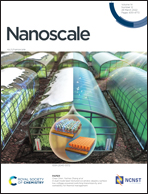Self-limiting nitrogen/hydrogen plasma radical chemistry in plasma-enhanced atomic layer deposition of cobalt†
Abstract
Cobalt (Co) is a potential candidate in replacing copper for interconnects and has been applied in trenches in the semiconductor industry for over twenty years. A non-oxidizing reactant is required in the plasma-enhanced atomic layer deposition (PE-ALD) of thin films of metals to avoid O-contamination. PE-ALD of Co has been demonstrated experimentally with plasma sources of NH3 or a mixture of N2 and H2, but the growth mechanism and key reactions are not clear. In this study, we have investigated the reactions of plasma-generated predominant species, i.e. radicals ˙H, ˙N, ˙NH and ˙NH2, at metal precursor (CoCp2) treated Co(001) and Co(100) surfaces using static DFT calculations at 0 K and molecular dynamics simulations at 600 K. The proposed reaction mechanisms are (1) ˙N radicals play an important role in eliminating the surface-bound Cp ligand (if any) via pyridine (C5H5N) formation and desorption, whereas ˙H radicals have endothermic reactions for eliminating the Cp ligand via CpH formation and desorption; (2) the surface NHx species are eliminated by ˙H radicals via NH3 formation and desorption. The simulations of these key reactions show that on the Co(001) surface, the remaining Cp ligand and surface NHx species after the metal precursor pulse will be completely removed with ˙N and ˙H radicals, resulting in Co atoms deposited on the Co(001) surface at a coverage of 3.03 Co nm−2. However, on the Co(100) surface, the surface NH2 species cannot be completely removed via NH3 formation and desorption due to overall endothermic reactions. Instead, ˙H radicals react with trench N species, resulting from H transfer in the metal precursor pulse, to form NH. These trench N species cannot be eliminated completely on the Co(100) surface, which will be the source of N impurities in the deposited Co thin films. At the post-plasma stage, the metal surface will be covered with NHx-terminations with plasma generated ˙NH radicals and is then ready for the next deposition cycle. Our DFT results highlight and explain why ammonia or H2/N2 plasma, which produce NHx species, are required to deposit high-quality and low-impurity Co thin films using Co metallocene precursors.



 Please wait while we load your content...
Please wait while we load your content...